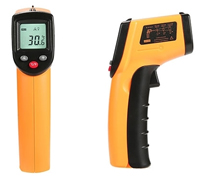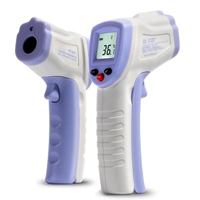Infrared Thermometer for Steel Smelting Industry
In the steel production process, monitoring the temperature is essential to improve productivity and product quality. Whether the temperature of the production process is within the range required by the process; whether the temperature of the heating furnace is too low or too high; whether the rolling mill needs to be adjusted, or to what extent it needs to be cooled, infrared thermometers can solve these problems well. Infrared thermometers are mainly used in continuous casting, hot blast furnace, hot rolling, cold rolling, bar and wire rolling in the steel processing and manufacturing process. It precisely monitors each stage so that the steel maintains the correct metallurgical properties throughout the machining process. Infrared thermometers can help improve product quality and productivity, reduce energy consumption and enhance personnel safety. The sensor head of ATO infrared thermometer has a digital circuit, which can remotely set the parameters of the sensor head in the control room, which makes the function enhancement and control more perfect, which is especially important for metal materials with changing emissivity.

Accurate temperature measurement is the key to producing quality products and increasing productivity. When continuous casting turns molten steel into slabs or billets, production reductions or shutdowns may occur. At this time, accurate real-time temperature monitoring is required, along with nozzle and flow adjustment to provide proper cooling to ensure billets. The required metallurgical properties result in a quality product, increased productivity and extended equipment life.
Continuous temperature measurement and frame adjustment can ensure product quality and normal use of the production line, and avoid unplanned downtime. High-performance two-color infrared thermometers or line-scan infrared thermometers with 1mm wavelength can be installed before descaling and roughing mills to help operators check product temperature for rolling requirements and use it accordingly Set the parameters of the roughing mill accordingly. The billet continues to cool until it enters the rolling mill, and if the line is stopped for a period of time, the billet may be colder than it was before it was restarted, so the rolls must be set to compensate for the corresponding change in temperature. The rolls can be manually set by the operator, or an infrared thermometer can be installed in front of each rolling mill. In order to eliminate the influence of steam and dust on the temperature measurement in the control cooling zone, the use of a colorimetric thermometer can accurately measure the temperature even when the energy of the target is blocked by 95%. In the hot rolling process, usually cooled steel sheets are coiled by coilers into coils for transport to cold rolling or other facilities. To keep the laminar cooling zone reasonably cool, accurate temperature measurement is required at the coiler. The temperature at this point is critical because it determines whether the steel is properly cooled before coiling. Otherwise, unreasonable cooling may change the metallurgical properties of the steel and cause scrap. Since the temperature at this point is low and the steel is running at 75-100 feet per second, a low temperature series infrared thermometer with fast response time is required.
 Some rolling mills form coils where hot steel is made into coils after rough rolling and shipped elsewhere in the mill. At the point of uncoiling in hot rolling, accurate measurement and monitoring of the temperature is very important because the operator sets the parameters of the finishing mill rolls accordingly. Coils are often formed after finishing cooling is completed, and the coils are shipped to another site of the mill for cold rolling or to other mills. Cold rolling makes the steel a thinner and flatter product, when the steel is done at an ambient temperature of about 94°C. The high temperature infrared thermometers installed between each finishing mill allow the operator to make adjustments to the mill based on detected temperature changes. Another high-speed process is bar and wire rolling, where billets are reheated and sent for rolling into bars. After this, the bar goes through a series of intermediate rollings that process the bar into different sizes. After finishing rolling, the bar can be made into hundreds of different products. Reheating the billet to a uniform temperature is critical throughout the rolling process because uneven bar temperatures can age equipment and increase equipment downtime for maintenance. Knowing the product temperature between the stands allows the operator to adjust the rolls as required. As the product begins to enter the cooling zone, the cooling temperature is quickly and carefully monitored to ensure product metallurgical properties. If the cooling control is not good, the product will not meet the process specification requirements, resulting in lower quality or scrap. In some production processes, such as high-speed rolling and vibrating thin rod or wire products, temperature measurement is difficult, and high-performance infrared two-color thermometers can solve this problem. When the target deviates from the field of view or is partially blocked (dust, vapor, obstacles, etc.), the dual infrared thermometer can still accurately measure temperature.
Some rolling mills form coils where hot steel is made into coils after rough rolling and shipped elsewhere in the mill. At the point of uncoiling in hot rolling, accurate measurement and monitoring of the temperature is very important because the operator sets the parameters of the finishing mill rolls accordingly. Coils are often formed after finishing cooling is completed, and the coils are shipped to another site of the mill for cold rolling or to other mills. Cold rolling makes the steel a thinner and flatter product, when the steel is done at an ambient temperature of about 94°C. The high temperature infrared thermometers installed between each finishing mill allow the operator to make adjustments to the mill based on detected temperature changes. Another high-speed process is bar and wire rolling, where billets are reheated and sent for rolling into bars. After this, the bar goes through a series of intermediate rollings that process the bar into different sizes. After finishing rolling, the bar can be made into hundreds of different products. Reheating the billet to a uniform temperature is critical throughout the rolling process because uneven bar temperatures can age equipment and increase equipment downtime for maintenance. Knowing the product temperature between the stands allows the operator to adjust the rolls as required. As the product begins to enter the cooling zone, the cooling temperature is quickly and carefully monitored to ensure product metallurgical properties. If the cooling control is not good, the product will not meet the process specification requirements, resulting in lower quality or scrap. In some production processes, such as high-speed rolling and vibrating thin rod or wire products, temperature measurement is difficult, and high-performance infrared two-color thermometers can solve this problem. When the target deviates from the field of view or is partially blocked (dust, vapor, obstacles, etc.), the dual infrared thermometer can still accurately measure temperature.
ATO provides handheld infrared thermometers with distance to spot ratio up to 12:1, and high temperature range and distance spot ratio 20:1 or 50:1, portable and lightweight, which meet your different requirements.

